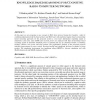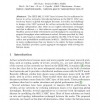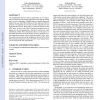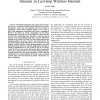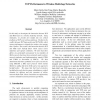124
Voted
ICC
2009
IEEE
14 years 10 months ago
2009
IEEE
Abstract-- Wireless sensor networks (WSNs) require energyef cient protocols to improve the network lifetime. In this work, we adopt a cross-layer strategy that considers routing an...
95
Voted
WINET
2010
14 years 10 months ago
2010
Abstract The design of single transceiver based multichannel multi-hop wireless mesh networks focuses on the trade-off between rapid neighbor synchronization and maximizing the usa...
99
Voted
CCR
2004
15 years 7 days ago
2004
A wireless ad hoc network is formed by a group of wireless hosts, without the use of any infrastructure. To enable communication, hosts cooperate among themselves to forward packet...
CORR
2010
Springer
15 years 14 days ago
2010
Springer
: In this paper we are proposing a new concept in MAC layer protocol design for Cognitive radio by combining information held by physical layer and MAC layer with analytical engine...
97
Voted
ADHOC
2008
15 years 15 days ago
2008
Abstract. The IEEE 802.11 MAC layer is known for its unfairness behavior in ad hoc networks. Introducing fairness in the 802.11 MAC protocol may lead to a global throughput decreas...
136
Voted
PEWASUN
2007
ACM
15 years 1 months ago
2007
ACM
The neighborhood discovery and its maintenance are very important in wireless networks for any applications, especially for routing and every self-∗ algorithm. Neighbor nodes ar...
127
click to vote
ICC
2007
IEEE
15 years 4 months ago
2007
IEEE
This paper concerns the cross-layer design between physical layer and MAC (Multiple Access Control) layer in asynchronous wireless random access network. The proposed cross-layer d...
139
Voted
BROADNETS
2007
IEEE
15 years 4 months ago
2007
IEEE
Multimedia applications have unique characteristics that can be leveraged to design energy-efficient loss recovery mechanisms. Given their loss tolerance and strict timing requirem...
110
click to vote
WMCSA
1999
IEEE
15 years 4 months ago
1999
IEEE
In this study we investigate the interaction between TCP and MAC layer in a wireless multi-hop network. Using simulation, we provide new insight into two critical problems of TCP ...
149
Voted
LANC
2009
ACM
15 years 5 months ago
2009
ACM
We study a wireless network under the 802.11 random access protocol, supporting multiple physical layer rates. Based on models for the effective packet rates achieved at the MAC ...

